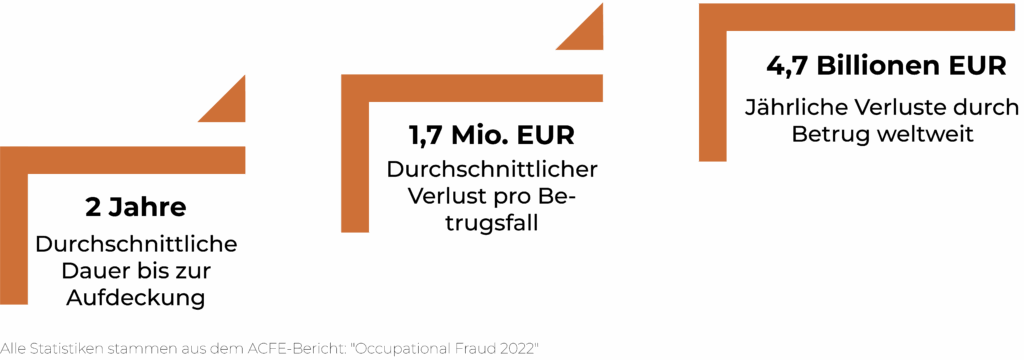Fraud Check – Your Protection Against Internal and External Threats
Corporate fraud costs businesses billions annually, leading to severe reputational damage and liability risks for responsible executives. Would you like to ensure that your company is protected from issues such as false invoices, payment fraud, or supplier kickbacks? The Averdes Fraud Check helps you identify such risks early and strengthen your internal controls.
Is 100% Fraud Prevention Possible?
Could an undetected case of internal fraud still be lurking in your company?
Could external attacks such as CEO fraud, spoofing, phishing, or cyber incidents lead to unauthorized transactions?
Even though standard controls detect most fraud cases, businesses still lose billions to employees with criminal intent or organized external fraudsters.
The longer such cases remain undetected, the greater the financial impact and damage to trust.
On average, companies lose around 5% of their annual profit through direct and indirect fraud-related costs

„The longer fraud goes undetected, the greater the potential losses — and the harder it becomes to recover them."

No organization is 100% free of human error or system flaws.
Our Solution:
The Fraud-Check
Fraud often remains hidden because individual data points appear normal on their own. However, when combined in a deep analysis
and compared against historical fraud patterns, suspicious trends emerge.
Here are some key aspects of our Fraud-Check methodology:
Comprehensive Invoice & Payment Analysis: No random sampling — we conduct a 100% review of all transactions.
Employee Collusion & Supplier Kickbacks: We analyse links between employees and vendors to detect conflicts of interest.
Payments to High-Risk Entities: We create a risk profile for all payment recipients to identify connections to sanctioned, flagged, or suspicious organizations.
Tax Information Validation: identification of potential fraud through non-existent entities; based on 250,000 validations,
approx. 4% of supplier tax IDs or VAT numbers are found to be invalid.
Anomalous System Activity: detection of unusual activity such as rare users, atypical posting or approval times, bypassing standard approval workflows (e.g., bank detail changes), or suspicious overlaps between business partners.
Typical patterns of fraud cases
Increasing Invoice Amounts:
Fraudulent or irregular
payments often begin with
small invoice amounts that
go unnoticed and bypass approval thresholds.
Once successful, the amounts typically increase over time — sometimes even disproportionately — forming a recognizable and recurring pattern.
Beträge an, später auch
überproportional und
ergeben so ein auffälliges
und häufig erlebtes Muster.
Benford’s
Law:
The first digits of invoice
numbers usually follow
certain statistical probabilities.
Deviations from these expected
patterns may indicate manually created or falsified invoices, since such numbering often stems from human input rather than automated systems.
Software, sondern ein
Mensch diese Nummer
manuell vergeben hat.
Sequential Invoice Numbers:
Why does one of your
vendors use strictly sequential invoice numbers?
Because this vendor may have only one customer – your company. A possible indicator of a shell company risk or a fictitious vendor relationship.
dieser Lieferant nur einen
einzigen Kunden hat: Sie.
Ein Hinweis auf einen
potenziellen
Scheinfirmenbetrug?
